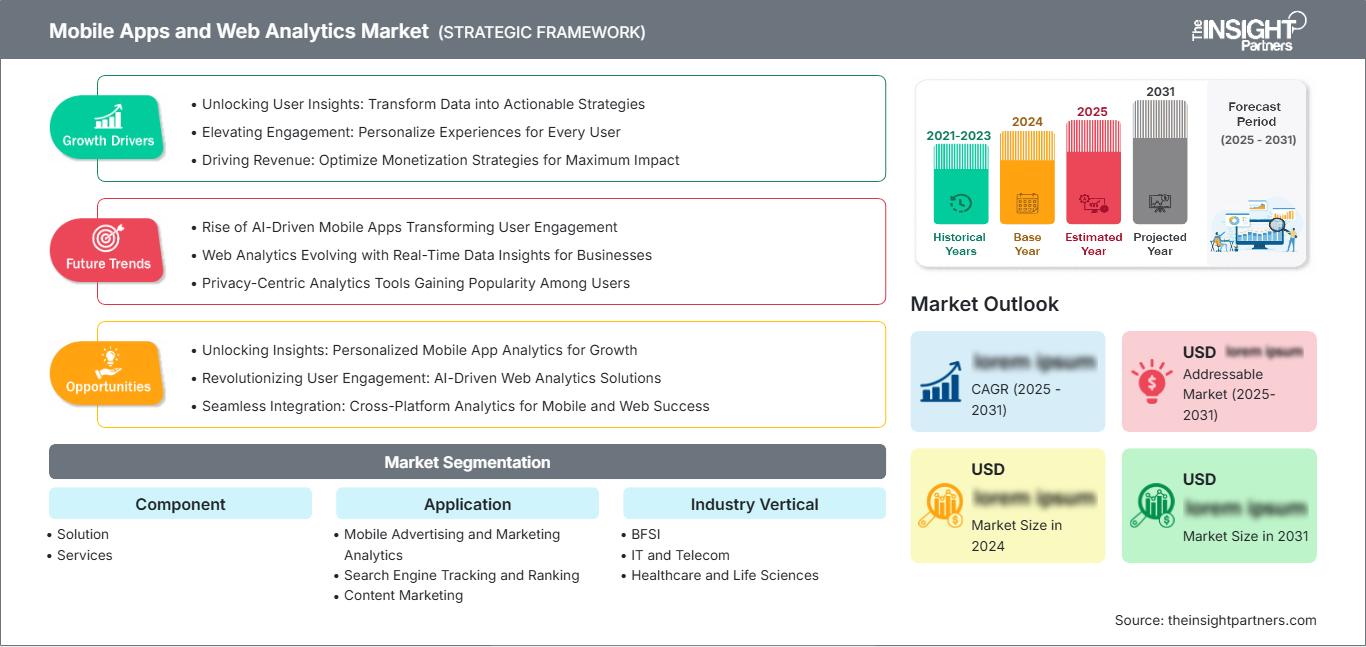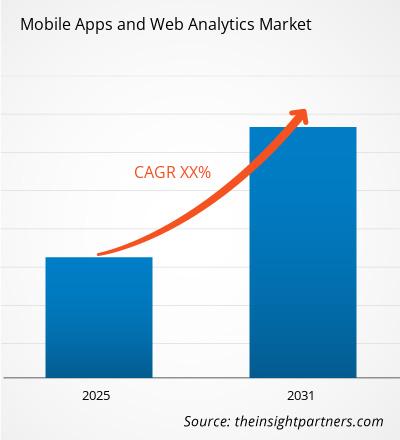Der Markt für mobile Apps und Webanalyse wird voraussichtlich von 2026 bis 2034 ein kontinuierliches Wachstum verzeichnen. Die Marktkapitalisierung soll gegenüber dem Basisjahr 2025 steigen und bis zum Ende des Prognosezeitraums ein nachhaltiges Wachstum aufweisen. Dieser Trend spiegelt positive Marktaussichten wider, die durch sich wandelnde Branchenanforderungen und fortschreitende technologische Entwicklungen begünstigt werden.
Der Bericht ist nach Komponenten (Lösungen, Dienstleistungen) kategorisiert und analysiert den Markt zudem anhand von Anwendungen (Mobile Werbung und Marketinganalysen, Suchmaschinen-Tracking und -Ranking, Content-Marketing, In-App- und Web-Verhaltensanalyse). Er untersucht den Markt außerdem nach Branchen (Banken, Finanzdienstleistungen und Versicherungen, IT und Telekommunikation, Gesundheitswesen und Biowissenschaften, Einzelhandel und E-Commerce, Reise und Gastgewerbe, Regierung). Für jedes dieser Schlüsselsegmente wird eine umfassende Aufschlüsselung auf globaler, regionaler und Länderebene bereitgestellt.
Der Bericht enthält Marktgrößen und Prognosen für alle Segmente, angegeben in US-Dollar. Er liefert außerdem wichtige Statistiken zum aktuellen Marktstatus führender Akteure sowie Einblicke in vorherrschende Markttrends und neue Chancen.
Zweck des Berichts
Der Bericht „Markt für mobile Apps und Webanalyse“ von The Insight Partners beschreibt die aktuelle Marktlage und das zukünftige Wachstum sowie die wichtigsten Triebkräfte, Herausforderungen und Chancen. Er bietet Einblicke für verschiedene Akteure im Geschäftsbereich, darunter:
- Technologieanbieter/Hersteller: Um die sich entwickelnde Marktdynamik zu verstehen und die potenziellen Wachstumschancen zu erkennen, damit sie fundierte strategische Entscheidungen treffen können.
- Investoren: Um eine umfassende Trendanalyse hinsichtlich der Marktwachstumsrate, der finanziellen Marktprognosen und der Chancen entlang der gesamten Wertschöpfungskette durchzuführen.
- Regulierungsbehörden: Zur Regulierung von Richtlinien und Überwachungstätigkeiten auf dem Markt mit dem Ziel, Missbrauch zu minimieren, das Vertrauen der Anleger zu erhalten und die Integrität und Stabilität des Marktes zu wahren.
Marktsegmentierungskomponente für mobile Apps und Webanalyse
- Lösung
- Dienstleistungen
Anwendung
- Mobile Werbung und Marketinganalyse
- Suchmaschinen-Tracking und Ranking
- Content-Marketing
- In-App- und Web-Verhaltensanalyse
Branchensegment
- BFSI
- IT und Telekommunikation
- Gesundheitswesen und Biowissenschaften
- Einzelhandel und E-Commerce
- Reise und Gastgewerbe
- Regierung
Sie erhalten eine kostenlose Anpassung aller Berichte – einschließlich Teilen dieses Berichts, Länderanalysen und Excel-Datenpaketen – sowie attraktive Angebote und Rabatte für Start-ups und Universitäten.
Markt für mobile Apps und Webanalyse: Strategische Einblicke

-
Ermitteln Sie die wichtigsten Markttrends dieses Berichts.Diese KOSTENLOSE Probe beinhaltet eine Datenanalyse, die von Markttrends bis hin zu Schätzungen und Prognosen reicht.
Wachstumstreiber des Marktes für mobile Apps und Webanalyse
- Nutzereinblicke erschließen: Daten in umsetzbare Strategien verwandeln
- Steigerung des Nutzerengagements: Personalisierte Erlebnisse für jeden Nutzer
- Umsatzsteigerung: Monetarisierungsstrategien für maximale Wirkung optimieren
Markt für mobile Apps und Webanalyse: Zukunftstrends
- Der Aufstieg KI-gesteuerter mobiler Apps verändert die Nutzerinteraktion
- Webanalyse entwickelt sich weiter – mit Echtzeit-Dateneinblicken für Unternehmen
- Datenschutzorientierte Analysetools gewinnen bei Nutzern an Beliebtheit
Marktchancen für mobile Apps und Webanalyse
- Erkenntnisse freisetzen: Personalisierte Mobile-App-Analysen für Wachstum
- Revolutionierung der Nutzerinteraktion: KI-gestützte Webanalyselösungen
- Nahtlose Integration: Plattformübergreifende Analysen für den Erfolg auf Mobilgeräten und im Web
Markteinblicke in den Bereich Mobile Apps und Webanalyse: Regionale Einblicke
Die regionalen Trends und Einflussfaktoren auf den Markt für mobile Apps und Webanalyse im Prognosezeitraum wurden von den Analysten von The Insight Partners ausführlich erläutert. Dieser Abschnitt behandelt außerdem die Marktsegmente und die geografische Verteilung des Marktes für mobile Apps und Webanalyse in Nordamerika, Europa, Asien-Pazifik, dem Nahen Osten und Afrika sowie Süd- und Mittelamerika.
Umfang des Marktberichts zu mobilen Apps und Webanalyse
| Berichtattribute | Details |
|---|---|
| Marktgröße im Jahr 2025 | XX Millionen US-Dollar |
| Marktgröße bis 2034 | XX Millionen US-Dollar |
| Globale durchschnittliche jährliche Wachstumsrate (2026 - 2034) | XX% |
| Historische Daten | 2021-2024 |
| Prognosezeitraum | 2026–2034 |
| Abgedeckte Segmente |
Nach Komponente
|
| Abgedeckte Regionen und Länder |
Nordamerika
|
| Marktführer und wichtige Unternehmensprofile |
|
Marktdichte der Akteure im Bereich mobiler Apps und Webanalyse: Auswirkungen auf die Geschäftsdynamik verstehen
Der Markt für mobile Apps und Webanalyse wächst rasant, angetrieben durch die steigende Nachfrage der Endnutzer. Gründe hierfür sind unter anderem sich wandelnde Verbraucherpräferenzen, technologische Fortschritte und ein wachsendes Bewusstsein für die Vorteile der Produkte. Mit steigender Nachfrage erweitern Unternehmen ihr Angebot, entwickeln innovative Lösungen, um den Bedürfnissen der Verbraucher gerecht zu werden, und nutzen neue Trends, was das Marktwachstum zusätzlich beflügelt.

- Verschaffen Sie sich einen Überblick über die wichtigsten Akteure im Markt für mobile Apps und Webanalyse.
Wichtigste Verkaufsargumente
- Umfassende Abdeckung: Der Bericht bietet eine umfassende Analyse der Produkte, Dienstleistungen, Typen und Endnutzer des Marktes für mobile Apps und Webanalyse und vermittelt so ein ganzheitliches Bild.
- Expertenanalyse: Der Bericht basiert auf dem fundierten Wissen von Branchenexperten und Analysten.
- Aktuelle Informationen: Der Bericht gewährleistet Geschäftsrelevanz durch die Berücksichtigung aktueller Informationen und Datentrends.
- Anpassungsmöglichkeiten: Dieser Bericht kann an die spezifischen Anforderungen des Kunden angepasst werden und sich optimal in die Geschäftsstrategien einfügen.
Der Forschungsbericht zum Markt für mobile Apps und Webanalyse kann daher maßgeblich dazu beitragen, das Branchenszenario und die Wachstumsaussichten zu entschlüsseln und zu verstehen. Auch wenn einige berechtigte Bedenken bestehen, überwiegen die Vorteile dieses Berichts insgesamt die Nachteile.
- Historische Analyse (2 Jahre), Basisjahr, Prognose (7 Jahre) mit CAGR
- PEST- und SWOT-Analyse
- Marktgröße Wert/Volumen – Global, Regional, Land
- Branchen- und Wettbewerbslandschaft
- Excel-Datensatz
Aktuelle Berichte
Verwandte Berichte
Erfahrungsberichte
Grund zum Kauf
- Fundierte Entscheidungsfindung
- Marktdynamik verstehen
- Wettbewerbsanalyse
- Kundeneinblicke
- Marktprognosen
- Risikominimierung
- Strategische Planung
- Investitionsbegründung
- Identifizierung neuer Märkte
- Verbesserung von Marketingstrategien
- Steigerung der Betriebseffizienz
- Anpassung an regulatorische Trends






















 Kostenlose Probe anfordern für - Markt für mobile Apps und Webanalyse
Kostenlose Probe anfordern für - Markt für mobile Apps und Webanalyse